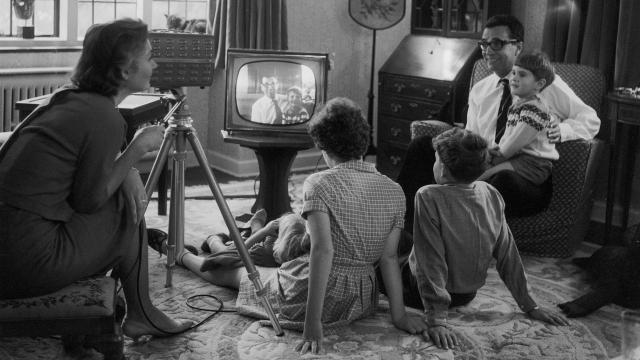The AMC show Mad Men is in its final season, with its mid-season finale (yeah, I don’t know what that means exactly either) airing this past Sunday. The show started with 1960 as its backdrop, and we now see characters in the world of 1969. A lot changed in that decade and, of course, it’s a fictional representation of history. But in the real world of 1960, people were making their own predictions for what was to come one decade hence.
Picture: Comedian Michael Bentine trying out a home video kit with his family on July 14, 1963 via Getty Images
Today we have a few of those predictions from the 3 January 1960 issue of American Weekly magazine about what the world would look like by 1970. Video, for instance, as we see in the photo above from 1963, would make home movies that much easier. Sunday’s episode was set during the July 1969 moon landing. But as we see from the predictions below we may have landed on the moon — but neither Don Draper, nor his real-world counterparts, got exactly what was promised by the end of the 1960s.
The prognosticators of American Weekly got a lot right, like advancements in video and satellite tech. But they were a bit too optimistic about other stuff, like speech recognition and weather control.
From American Weekly:
Transportation
Your first trip to Europe may be on a hydrofoil ship that lifts out of the ocean on a ski-like projections and skims at 60 miles an hour.
Your aircar, already produced, will float without a bump at high speed just above land, water and swamp.

Communication and Media
You’ll probably be able to dial your phone for points any place in the world. And you’ll be called to the phone, while walking outside by your individual radio receiver buzzing your own code signal.
You’ll take pictures of your family on a hand TV camera, complete with video tape, and play the results right back through your TV screen.
Work and Home
Your secretary will use a phonetic typewriter, talking into it and watching the printed words unfold on paper.
The upcoming farmer will direct work by two-way radio, grade fruits and vegetables electronically, and run his farm machinery with solar and atomic energy. He’ll control scattered operations through closed circuit TV.
There’ll be a house covering that shifts to a light colour on warm days to repel the sun’s rays, to a darker colour on cold days to retain them. And you’ll see a house built without hammer and nail… pieces will be held together by a new miracle glue, one drop of which on a bar of iron has already held up a car with four passengers!

Space Travel
By 1970 traffic in outer space won’t be exactly like Forty-Second and Broadway, but you’ll given no more thought to a satellite than to a neon sign on the main stem.
There’ll be manned space stations fixed 22,000 miles above the equator, linking all of the world’s major cities with live television and also serving as “orbital post offices” — handling mail at greater speed and lower cost than today’s air and surface transportation systems.
Earth-circling bodies will give instantaneous warning of an enemy’s missile-launching (at that, we’ll have only 30 minutes time to combat it). There’ll be another group of weather satellites, a great boon to warmer, commuter and housewife alike. You’ll be able to snap on a TV screen and see the weather 1,000 miles away. Then there’ll be a navigation satellite that will tell ships and aircraft instantly exactly where they are. It’s likely that the pilotless plane will deliver mail, equipment, merchandise (everything but people) between countries and cities… missile trucking systems.
We won’t try to beat Russia in the space race, but we’re on schedule with out plan to put a man into space about August 1961. Landing on the moon? The Air Force says yes, other services no. But most experts agree we’ll be circling it almost as a vacation treat.
War
Tomorrow’s soldier will look like a superman from Mars. He’ll wear an individual rocket belt enabling him to jump rivers, leap to housetops and hop about the countryside at 40 miles an hour. He’ll ride a jet-powered, biscuit-like flying jeep from base to base or to the battle lines at 150 miles an hour. He’ll have two-way radio in his helmet, special goggles for seeing through fog and rain, carry a bazooka-type atomic gun to shoot down planes.
The once-declining Navy will come into its own with 14 atomic subs carrying Polaris missiles, one of our prime weapons, and ships using newly developed foods from the ocean will be able to stay at sea indefinitely.
We’ll take the sting out of hurricanes by “seeding” them and weakening them so they can be diverted from shore. Increased industrialisation will warm our temperature a degree or two. We’ll be able (but will we want?) to melt the Arctic icecap in five years time by exploding “clean” atomic bombs to create ice fogs that hold in the Arctic summer’s warmth. We’ll create desired rainfall at will and weather forecasting will be 90 per cent accurate for three months ahead.
